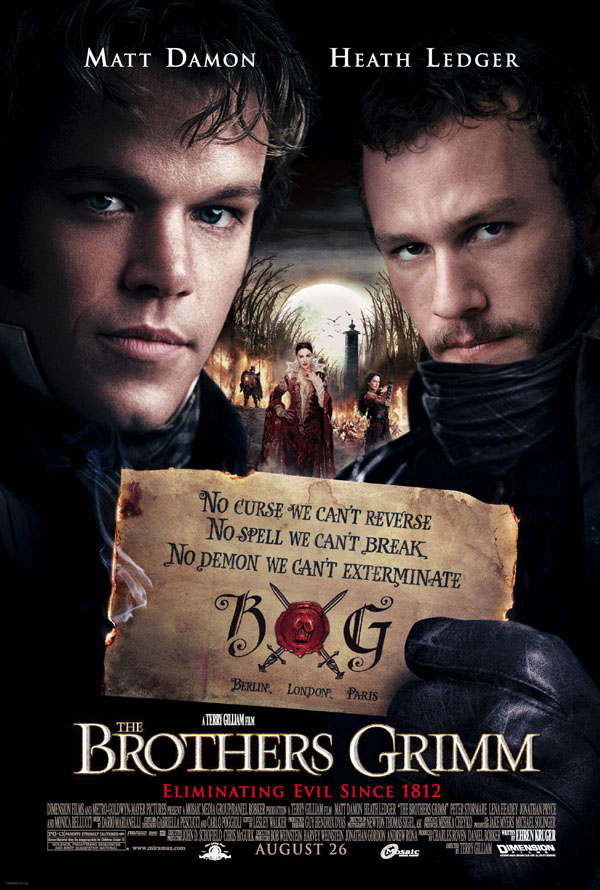Angelina Jolie feels neglected while Matt Damon looks to a long future of waterboarding and cherry-picking intelligence for political reasons in the new trailer for Robert De Niro’s The Good Shepherd, also starring De Niro, John Turturro, Alec Baldwin, William Hurt, Billy Crudup, Joe Pesci, and Michael Gambon.
Tag: William Hurt
Go Tell It on the Mountain.
The 2006 Oscar nominations are announced, with, to noone’s surprise, Brokeback Mountain leading the pack. Most of the major categories seem to be already locked up — Picture (Brokeback), Director (Ang Lee), Actor (Hoffman for Capote), Actress (Witherspoon for Walk the Line, barring a Huffman upsurge), Supporting Actress (Weisz, The Constant Gardener.) Of the Best Picture candidates (Brokeback, Capote, Munich, Good Night, and Good Luck), the only one I haven’t seen is Crash, but given its very mixed reviews, I’d be extremely surprised if it’s a better movie than Syriana or The New World.
Biggest snub? Jeff Daniels should be in Best Supporting Actor for The Squid and the Whale (William Hurt took his slot for A History of Violence.) Speaking of Supporting Actor, that category’s a two-man race between Clooney for Syriana and Paul Giamatti for Sideways. Giamatti’s been nominated for Cinderella Man, but many of his votes will be for the prior, passed-over film, just as Jim Broadbent won for Iris (over Ian McKellen as Gandalf) because of his performance in Moulin Rouge. Also, say what you will about Episode III, but it should be nominated in the visual effects category, even if Kong should win.
The most competitive of the major awards looks to be in the original screenplay division (Adapted will go to Team Brokeback, McMurtry & Ossana). If Clooney doesn’t win director or supporting actor, he could very well win here for GN & GL. Or, the academy might decide to reward a movie they otherwise overlooked: Syriana, Squid & the Whale, or Match Point. Hard to say — I guess I’ll go with GN & GL for now.
2005 in Film.
Happy New Year’s Eve to everyone..I’m celebrating in San Diego with old college friends and likely won’t update again until 2006. So, without further ado, here’s the 2005 movie round-up. Overall, it’s been a pretty solid year for cinema, and this is the first year in the past five where the #1 movie wasn’t immediately obvious to me. But, still, choices had to be made, and so…
[2000/2001/2002/2003/2004]
[Note: The #1 movie of 2005 changed in early 2006: See the Best of 2006 list for the update…]
1. Syriana: I know Stephen Gaghan’s grim meditation on the global reach and ruthlessness of the Oil Trade rubbed some people the wrong way, but I found it a gripping piece of 21st century muckraking, in the venerable tradition of Ida Tarbell and Upton Sinclair. True, Christopher Plummer was a mite too sinister, but otherwise Syriana offered some of the most intriguing character arcs of the year, from morose CIA Field Agent George Clooney’s ambivalent awakening to corporate lawyer Jeffrey Wright’s courtship with compromise. In a year of well-made political films, among them Good Night, and Good Luck, Munich, Lord of War, and The Constant Gardener, Syriana was the pick of the litter.
2. Layer Cake: If X3 turns into the fiasco the fanboy nation is expecting with Brett Ratner at the helm, this expertly-crafted crime noir by Matthew Vaughn will cut that much deeper. Layer Cake not only outdid Guy Ritchie’s brit-gangster oeuvre in wit and elegance and offered great supporting turns by Michael Gambon, Kenneth Cranham, and Colm Meaney, it proved that Daniel Craig had the requisite charisma for Bond and then some (and that Sienna Miller is no slouch in the charisma department either.)
3. Ballets Russes: Penguins and comedians, to the wings — The lively survivors of the Ballets Russes are now on center stage. Like the best in dance itself, this captivating, transporting documentary was at once of the moment and timeless.
4. Good Night, and Good Luck: Conversely, anchored by David Strathairn’s wry channeling of Edward R. Murrow, George Clooney’s second film (and second appearance on the 2005 list) couldn’t have been more timely. A historical film that in other hands might have come off as dry, preachy edutainment, Good Night, and Good Luck instead seemed as fresh and relevant as the evening news…well, that is, if the news still functioned properly.
5. Batman Begins: The Dark Knight has returned. Yes, the samurai-filled first act ran a bit long and the third-act train derailing needed more oomph. Still, WB and DC’s reboot of the latter’s second biggest franchise was the Caped Crusader movie we’ve all been waiting for. With help from an A-list supporting cast and a Gotham City thankfully devoid of Schumacherian statuary, Chris Nolan and Christian Bale brought both Batman and Bruce Wayne to life as never before, and a Killing Joke-ish Batman 2 is now on the top of my want-to-see list.
6. Harry Potter and the Goblet of Fire: As I said in my original review, I initally thought Cuaron’s Azkhaban couldn’t be topped. But give Mike Newell credit: Harry’s foray into Voldemortish gloom and teenage angst was easily the most compelling Potter film so far. Extra points to Gryffindor for Brendan Gleeson’s more-than-slightly-bent Mad-Eye Moody, and to Slytherin for Ralph Fiennes’ serpentine cameo as He-Who-Must-Not-Be-Named.
7. King Kong: I had this film as high as #2 for awhile, and there are visual marvels therein that no other movie this year came close to offering, most notably Kong loose in Depression-Era New York City. But, there’s no way around it — even given all the B-movie thrills and great-ape-empathizing that PJ offers in the last 120 minutes, the first hour is close to terrible, which has to knock the gorilla down a few notches.
8. Capote: When it comes to amorality for artistry’s sake, Jack Black’s Carl Denham ain’t got nothing on Philip Seymour Hoffman’s Truman Capote. I think it’d be awhile before I want to watch this movie again, but, still, it was a dark, memorable trip into bleeding Kansas and the writerly id.
9. Sin City: One of the most faithful comic-to-film adaptations on celluloid also made for one of the more engaging and visually arresting cinematic trips this year. I don’t know if the look and feel of Sin City can sustain a bona fide franchise, but this first outing was a surprisingly worthwhile film experience (with particular kudos for Mickey Rourke’s Marv.)
10. Munich: I wrote about this one at length very recently, so I’ll defer to the original review.
11. Brokeback Mountain: A beautifully shot and beautifully told love story, although admittedly Ang Lee’s staid Brokeback at times feels like transparent Oscar bait.
12. Lord of War: Anchored by Nicholas Cage’s wry voiceover, Andrew Niccol’s sardonic expose of the arms trade was the funniest of this year’s global message films (That is, if you like ’em served up cold.)
13. The Squid and the Whale: Speaking of which, The Squid and the Whale made ugly, embittered divorce about as funny as ever it’s likely to get, thanks to Jeff Daniels’ turn as the pretentious, haunted Bernard Berkman.
14. Star Wars Episode III: Revenge of the Sith: Thank the Force for small kindnesses: George Lucas put the Star Wars universe to bed with far and away his best outing of the prequels. The film flirts dangerously with the Dark Side, particularly in the “let’s take a meeting” second act, but for the most part Sith felt — finally — like a return to that galaxy long ago and far, far away.
15. A History of Violence: I think David Cronenberg’s most recent take on vigilantism and misplaced identity was slightly overrated by most critics — When you get down to it, the film was pretty straightforward in its doling out of violent fates to those who most deserved them. Still, solid performances and Cronenberg’s mordant humor still made for a far-better-than-average night at the movies.
16. Walk the Line: Despite the great performances by Joaquin Phoenix and Reese Witherspoon, Walk the Line ultimately seemed too much of a by-the-numbers biopic to do the Man in Black full credit. But, definitely worth seeing.
17. In Good Company (2004): Paul Weitz’s sweet folktale of synergy, downsizing, and corporate obsolescence was too charitable and good-natured to think ill of any of its characters, and I usually prefer more mordant fare. Nevertheless, the intelligently-written IGC turned out to be a quality piece of breezy pop filmmaking.
18. The Constant Gardener: Another very good film that I still thought was slightly overrated by the critics, Fernando Meirelles’ sophomore outing skillfully masked its somewhat iffy script with lush cinematography and choice Soderberghian editing.
19. Primer (2004): A completely inscrutable sci-fi tone poem on the perils of time travel. Kevin and I saw it twice and still have very little clue as to what’s going most of the time — but I (we?) mean that in the best way possible.
20. The Chronicles of Narnia: The Lion, the Witch, and the Wardrobe: The Chronic-what? Andrew Adamson’s retelling of C.S. Lewis’s most popular tome lagged in places, and the two older kids were outfitted with unwieldy character arcs that often stopped the film dead, but it still felt surprisingly faithful to the spirit of Narnia, Christianized lion and all.
Most Disappointing: The Fantastic Four, which I finally saw on the plane yesterday — One of Marvel’s A-List properties is given the straight-to-video treatment. From the Mr. Fantastic bathroom humor to the complete evisceration of Dr. Doom, this movie turned out just as uninspired and embarrassing as the trailers suggested. Runner-Up: The Brothers Grimm. Terry Gilliam’s long-awaited return wasn’t exactly a return-to-form. But, hey, at least he got a movie made, and Tideland is just around the corner.
Most Variable: Hitchhiker’s Guide to the Galaxy: I still haven’t figured out how I feel about this one. I liked it quite a bit upon first viewing, but it didn’t hold up at all the second time around. Still, the casting feels right, and I’d be up for The Restaurant at the End of the Universe, provided they turn up the Ford-and-Zaphod shenanigans and turn down the forced Arthur-and-Trillian romance.
Worth a Rental: Constantine, Aliens of the Deep, Me and You and Everyone We Know, Charlie and the Chocolate Factory, The Island, March of the Penguins, The Aristocrats,Tim Burton’s Corpse Bride, Jarhead, Sarah Silverman: Jesus is Magic, The Ice Harvest, War of the Worlds
Ho-Hum: Inside Deep Throat, The Jacket, Million Dollar Baby (2004), The Ring 2, Kingdom of Heaven, Unleashed, Mr. & Mrs. Smith,
Aeon Flux
Best Actor: Philip Seymour Hoffman, Capote; Eric Bana, Munich; Heath Ledger, Brokeback Mountain; David Straitharn, Good Night, and Good Luck
Best Actress: Reese Witherspoon, Walk the Line; Naomi Watts, King Kong
Best Supporting Actor: Jeff Daniels, The Squid and the Whale; George Clooney, Syriana; Brendan Gleeson, Harry Potter and the Goblet of Fire
Best Supporting Actress: Maria Bello, A History of Violence; Tilda Swinton, The Chronicles of Narnia
Unseen: The 40-Year-Old Virgin, Bee Season, Broken Flowers, Cache, Casanova, Cinderella Man, Crash, Enron: The Smartest Guys in the Room, Grizzly Man, Gunner Palace, Head On, Hustle & Flow, Junebug, Match Point, The New World, Nine Lives, Pride and Prejudice, Serenity (although I watched all of Firefly last week), Shopgirl, The Three Burials of Melquiades Estrada, Wallace and Gromit: The Curse of the Were-Rabbit, Wedding Crashers
2006: Frankly, the line-up doesn’t look too exciting at the moment. Nevertheless, 2006 will bring A Scanner Darkly, Casino Royale, The Da Vinci Code, Flags of our Fathers, The Good German, The Inside Man, Marie Antoinette, M:I III, Pirates of the Caribbean 2, Snakes on a Plane (!!), Southland Tales, Superman Returns, Tristam Shandy, V for Vendetta, and X3.
The Oil Down the Desert Way.
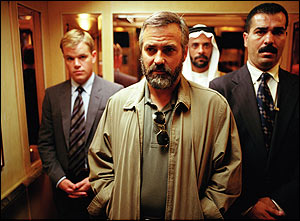 While perhaps a bit too dry and convoluted for some tastes, Stephen Gaghan’s Syriana is, IMHO, a top-notch political thriller that’s easily one of the best films of the year. Admitedly, the movie is missing some of the Soderberghian visual flourishes that made the very similar Traffic so memorable, and the movie definitely can be tough to follow. But, in a way, that’s part of its charm — Like the film’s protagonists, we only occasionally glimpse the shadowy tendrils of the beast that is Big Oil, and come to share their despair that it can ever be subdued. In sum, like the other recent Clooney outing, Good Night, and Good Luck, Syriana is both an intelligent, compelling work of cinema and a enthralling piece of social commentary, one that not only feels pertinent but necessary.
While perhaps a bit too dry and convoluted for some tastes, Stephen Gaghan’s Syriana is, IMHO, a top-notch political thriller that’s easily one of the best films of the year. Admitedly, the movie is missing some of the Soderberghian visual flourishes that made the very similar Traffic so memorable, and the movie definitely can be tough to follow. But, in a way, that’s part of its charm — Like the film’s protagonists, we only occasionally glimpse the shadowy tendrils of the beast that is Big Oil, and come to share their despair that it can ever be subdued. In sum, like the other recent Clooney outing, Good Night, and Good Luck, Syriana is both an intelligent, compelling work of cinema and a enthralling piece of social commentary, one that not only feels pertinent but necessary.
As you probably know, the movie jetsets around the globe following several facets of the oil trade and its consequences. In Beirut, an aging, disgruntled CIA agent (a stout George Clooney, resembling in Stephanie Zacharek’s words a “depressed circus bear”) starts to ask questions above his pay-grade about the collateral damage from a recent operation. In Geneva, after a family tragedy, a fresh-faced energy analyst (Matt Damon) becomes consigliere to the ambitious heir (Alexander Siddig) of a Middle-Eastern emirate. In Washington DC, a resourceful lawyer (Jeffrey Wright) begins due diligence work on an merger between two oil firms (the smaller headed by Chris Cooper). And, on the oil fields themselves, an increasingly desperate Pakistani emigrant (Mazhar Munir) begins to contemplate drastic action to change his fortunes, and those of his family.
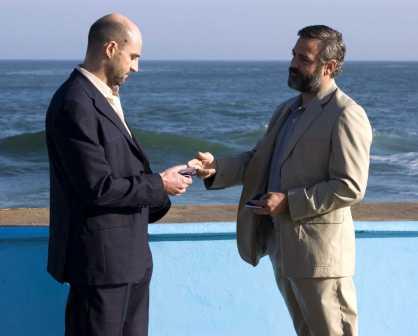 Along the way, Syriana‘s narrative is further fractured by the comings and goings of other famous faces, including Amanda Peet as Damon’s suffering wife, William Hurt as another grizzled agency vet, Tim Blake Nelson as the poster child for Abramoff‘s America, and Christopher Plummer as an insider among insiders. But, even though Plummer comes closest to being the Cigarette Smoking Man of this particular conspiracy tale, Syriana doesn’t offer any quick fixes or easy answers to the often grim story that unfolds. Some of our heroes find redemption or closure, true, but others become resigned to their fate, or even corrupted. And, ultimately, there is no Big Reveal or cathartic Speaking-Truth-To-Power scene to offer solace to the audience — Instead, we’re confronted with a system that, for better or worse, lumbers on, oblivious to either the machinations or the protests of mere individuals.
Along the way, Syriana‘s narrative is further fractured by the comings and goings of other famous faces, including Amanda Peet as Damon’s suffering wife, William Hurt as another grizzled agency vet, Tim Blake Nelson as the poster child for Abramoff‘s America, and Christopher Plummer as an insider among insiders. But, even though Plummer comes closest to being the Cigarette Smoking Man of this particular conspiracy tale, Syriana doesn’t offer any quick fixes or easy answers to the often grim story that unfolds. Some of our heroes find redemption or closure, true, but others become resigned to their fate, or even corrupted. And, ultimately, there is no Big Reveal or cathartic Speaking-Truth-To-Power scene to offer solace to the audience — Instead, we’re confronted with a system that, for better or worse, lumbers on, oblivious to either the machinations or the protests of mere individuals.
Depressing, indeed, even despairing at times, this film still feels like a story that must be told. And while viewers may quibble with some of the details of Gaghan’s Tarbell-esque expose of the political economy of oil, hopefully most will agree: We need more movies like Syriana.
Black Gold, Black Ops.
“Corruption is our protection. Corruption keeps us safe and warm. Corruption is why we win.” Tim Blake Nelson channels Boss DeLay in the new trailer for Stephen Gaghan’s Syriana (a.k.a.Traffic meets Big Oil), starring George Clooney, Matt Damon, Jeffrey Wright, Chris Cooper, Amanda Peet, Alexander Siddig, and Christopher Plummer.
Unsound Methods.
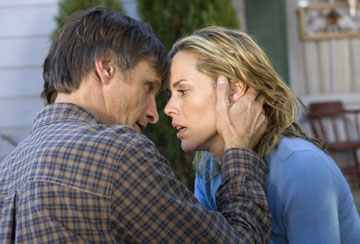
Given the very favorable (and somewhat spoilerish) reviews that David Cronenberg’s A History of Violence has been getting, I went in expecting a great film from this auteur of the disturbing (albeit one without the throbbing, fleshy, pulsating chunks of gristle usually associated with Cronenberg’s oeuvre.) But, while Violence is a good film with some excellent performances — most notably by Viggo Mortensen and Maria Bello — it is not ultimately a great one. In fact, I found it something of a letdown after all the hype. [Be warned: I don’t want to give everything away, but it’s a hard movie to talk about without delving into some very heavy spoilers, including the film’s conclusion.]
I’ve never read the source graphic novel, so I can’t vouch for the deviations in the tale, but it basically goes as follows: Viggo Mortensen is Tom Stall, a hard-working, Midwestern fella who runs the local diner in Smalltown USA. He is loved by his adoring, alluring wife (Bello, exquisite as usual), admired by his two children, respected by the community, and generally living the American dream, as long exemplified in Norman Rockwell paintings and The Saturday Evening Post. (A lot of this corn-fed small-town-America set-up — a little girl’s nightmare, a run-in with a high-school bully — comes off as completely flat and stilted, but I think there’s method in Cronenberg’s madness. What he’s doing is akin to the Naomi Watts/Nancy Drew stuff in the first half of David Lynch’s Mulholland Drive — he’s lulling us in with mundanity to knock us off-kilter later on.)
Anyway, Tom’s picture-perfect life goes awry after he becomes an unwitting “American Hero” media sensation by killing two Bad Men in his diner one evening. (We know they’re Bad Men because one of them blows away a little girl in the first five minutes, which seems like exceedingly cheap and lazy character development.) Soon, scraggly-looking n’er-do-wells like Ed Harris come-a-knockin’, convinced that Tom Stall is not Tom Stall at all, but rather…Aragorn of the Dunedain, Isildur’s Heir and a trained, lethal adversary. Ok, not quite…nevertheless, this case of mistaken identity eventually forces Stall to forego being a man of peace and come to grips with his violent tendencies. And, in true Cronenberg fashion, this violence soon seems to infect Stall’s world like a particularly dangerous viral meme, and threatens to transform forever the lives of he and his family.
Along the way, A History of Violence comments on many significant tropes in the history of violence — “justified” violence, parental violence, marital and sexual violence — culminating in a replay of the original Biblical murder (one which loses much of its force due to William Hurt being an insufferable hambone — Perhaps he and Harris should’ve switched roles.) And, to its credit, it leaves many of these setpieces tantalizingly ambiguous. Was Viggo’s kid right to smash up the bully? How should we feel about the incident on the stairwell? But, for all that, I’m with Edelstein — The larger arc of the story seems cartoonishly black-and-white. Yes, the last scene of the film is an undeniably powerful one, but, really, the Stalls get off easy. If violence, once unleashed, spreads like a wildfire, then how come only Bad People (or at the vey least Deserving People, like the bully) end up on its brunt end? True, Cronenberg shows us the gory consequences of murder (Throbbing Gristle sighting!), but never upon any character that we happen to like.
I can see the argument that the story had to end the way it did — with the Stalls perhaps physically unharmed but in spiritual turmoil — as a commentary on either the standard narrative of the Western (covered similarly in Unforgiven) or on Dubya’s foreign policy, which Cronenberg says is an analogy he and Viggo had in mind. Still, as it is, I think the story’s conclusion subverts the movie’s message. By leaving the white hats shaken, not stirred and the black hats pushing up daisies, A History of Violence ends up suggesting that violence is actually a rather effective way of dealing with Bad People, although it may cost you (sniff) a few tears. All in all, A History of Violence is a much-better-than-average movie and it’s one well worth seeing, but, in the end, I don’t think it quite holds up.

On War, Violence, and other Grimm Matters.
In this weekend’s movie bin, yet another new look at Stephen Spielberg’s War of the Worlds and a higher quality version of the trailer for David Cronenberg’s A History of Violence that premiered at Cannes last week. And, further into the future, the one-sheet for Terry Gilliam’s return, The Brothers Grimm, makes it online. Along with Heath Ledger, Matt Damon, and the lovely Monica Bellucci, Grimm also includes Peter Stormare and Jonathan Pryce. Seeing Sam Lowry back in the Gilliam-verse should be worth the price of admission by itself.
Aragoetz.
Courtesy of Cannes, the trailer for David Cronenberg’s A History of Violence, starring Viggo Mortensen, Maria Bello, Ed Harris, and William Hurt, is now online (in lousy formats). Seems strangely unCronenberg-like, from the previews…where are the fleshy, pulsating things? Perhaps this is his Straight Story.
The Village Idiot.
 Having completed my chores in timely fashion this past Sabbath morn, I decided to undertake a sojourn in M. Night Shyamalan’s The Village, in spite of my apprehension over The Curse of William Hurt and The Mel Gibson Film Which We Do Not Much Enjoy. As you perchance have ascertained, it seems the goodly people of this nonsensical village have experienced some difficulty with the strange and mysterious residents in the nearby woods. Alack, Number Six is nowhere to be found, and Goody Ellen Ripley seems too engaged sweeping and darning at the present time to handle the marauders in her usual efficacious manner. This is highly unfortunate, for M. Night Shyamalan’s The Village is an exceedingly drab and silly place, whose full terribleness can only adequately be described in spoiler-filled invisitext (Note: invisitext turned off — it’s been 15 years):
Having completed my chores in timely fashion this past Sabbath morn, I decided to undertake a sojourn in M. Night Shyamalan’s The Village, in spite of my apprehension over The Curse of William Hurt and The Mel Gibson Film Which We Do Not Much Enjoy. As you perchance have ascertained, it seems the goodly people of this nonsensical village have experienced some difficulty with the strange and mysterious residents in the nearby woods. Alack, Number Six is nowhere to be found, and Goody Ellen Ripley seems too engaged sweeping and darning at the present time to handle the marauders in her usual efficacious manner. This is highly unfortunate, for M. Night Shyamalan’s The Village is an exceedingly drab and silly place, whose full terribleness can only adequately be described in spoiler-filled invisitext (Note: invisitext turned off — it’s been 15 years):
Hoo boy…grab your torches and pitchforks, village people, cause we’ve got a really lousy film on our hands. (Ok, Van Helsing and Riddick were worse, but they harbored fewer delusions of grandeur…this film is just a pretentious bore.) As a refresher, I liked Sixth Sense, was intrigued by Unbreakable, and loathed Signs, and this one’s probably just as bad as Mel Gibson’s run-in with the water-and-door-averse aliens. Even though the plot twists in this bad boy can be seen a mile away, they still don’t make any sense. As with Signs, this is a film so lame I can only wrap my mind around it in numbered point form:
1) First off, the whole Elders bit. Is it really possible not to see this coming? What other explanation could there be for those big black cabinets in every house? I understand that these Villagers were not exposed to Scooby Doo, but how strikingly incurious could they be?
2) Along those lines, if you call a shed “The Old Shed That Is Not To Be Used” in any human society, no more than a week would pass before some enterprising youth started skulking around it. And why are the creatures called “Those We Shall Not Speak Of” anyway, when everyone is incessantly speaking about them? Surely some other nomenclature would take off at some point.
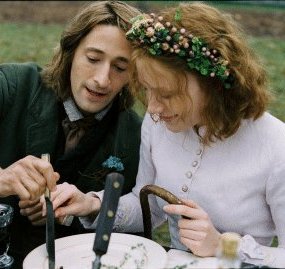 3) How come not a single Village soul has ever attempted to beat back the not-so-frightening wicker creatures with a block of wood or a stick of fire or something? Hasn’t anyone ever wondered why the Elders never seem to be around when the creatures come out?
3) How come not a single Village soul has ever attempted to beat back the not-so-frightening wicker creatures with a block of wood or a stick of fire or something? Hasn’t anyone ever wondered why the Elders never seem to be around when the creatures come out?
4) What is this clipped faux-nineteenth century argot everybody’s speaking in? It’s embarrassing (although A.O. Scott made an excellent point when he noted that this is how William Hurt sounds all the time. Perhaps this actually makes sense.)
5) After our worst fears about the Scooby Doo Elders have been confirmed, why would Shyamalan think the blind girl’s encounter in the woods would be scary in the slightest? The only real question was whether it was Brendan Gleeson or Adrien Brody in the costume.
6) What vested interest would the government have in protecting this village from fly-overs, poachers, etc.? Nada, zip, zero. We already have Colonial Williamsburg.
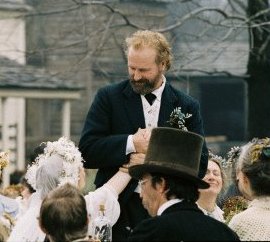 7) Whatsmore, I find the political economy of this film somewhat repellent. Is the urge to create a rigid, backward-looking, and authoritarian society — where everyone knows everyone else’s business (except of course, the Big Business), where the only people of color are Red, and where the only trouble around is Adrien Brody the Village Idiot — really as worthy and benign as Shyamalan makes it out to be? These people are nutjobs, but they’re portrayed as humanists. If anything, the end of the film makes it seem as if this noble way of life will and should go on. There’s no real critique made at all of the Elder’s impositions, only of its misuse by Jealous Brody.
7) Whatsmore, I find the political economy of this film somewhat repellent. Is the urge to create a rigid, backward-looking, and authoritarian society — where everyone knows everyone else’s business (except of course, the Big Business), where the only people of color are Red, and where the only trouble around is Adrien Brody the Village Idiot — really as worthy and benign as Shyamalan makes it out to be? These people are nutjobs, but they’re portrayed as humanists. If anything, the end of the film makes it seem as if this noble way of life will and should go on. There’s no real critique made at all of the Elder’s impositions, only of its misuse by Jealous Brody.
8) Speaking of which, village idiot? Blind girl who sees auras? C’mon now. You’re not even trying.
9) I see very well how Shyamalan might have intended this as a Twilight Zone meditation on terrorism, what with fear-mongering and color codes and all that. But, if that’s the case, then the film should not have been constructed as a Sixth Sense thriller rife with plot twists in the last third (particularly when the plot twists are so glaringly obvious). It should have shown its cards up front and then attempted to explore this allegory a little more creatively.
In sum, with Goody Weaver and Mssrs. Brody and Gleeson as residents of this unfortunate village, I had thought my brief stay in these woods might be more relishable. As it is, I am headed for the towns and shall not return.
Purple Village People Eaters.
Evil unseen alien forces threatening rustic Americana…let’s hope they can handle water this time. Yep, it’s the trailer for the new M. Night Shyamalan movie. With Sigourney Weaver, Adrien Brody, Brendan Gleeson, and a strange period vibe to it, I’d normally be quite enthused about The Village. But Signs was so lousy and self-absorbed that the bloom is off the Shyamalan rose, and this looks to me like more of the same. Plus, William Hurt has been phoning it in now for at least a decade, and he usually means the kiss of death for a film these days.

